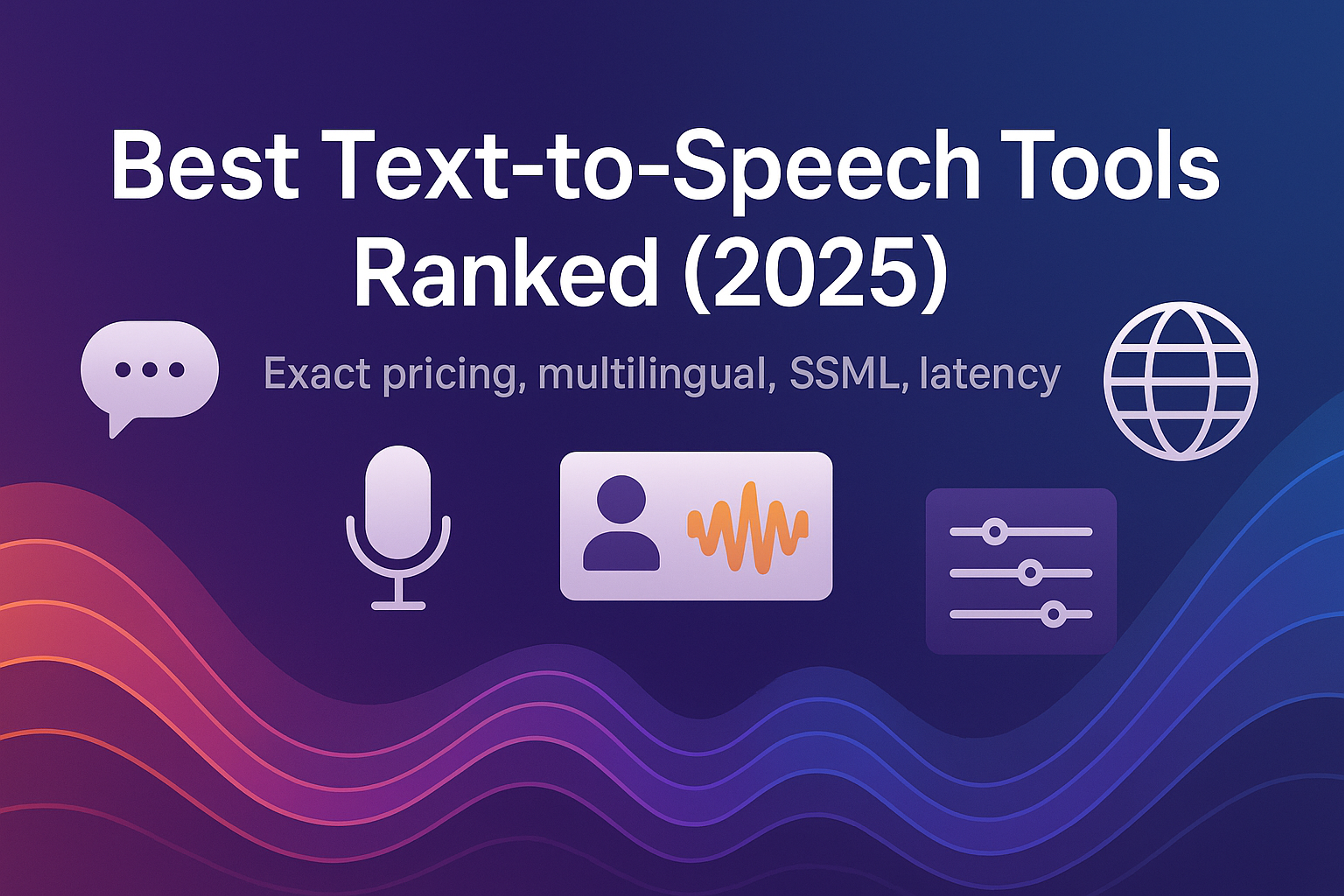Best Text to Speech Tools Ranked (2025)
You’ve got deadlines, we've got you tools to help you deliver. You need voices that sell the joke in a 6-second hook, carry authority in a product demo, and don’t fall apart when you switch from English to Hindi to Spanish in the same script. This guide is for the people shipping every day - creators, shorts editors, PMMs, educators, growth teams, and devs who live inside timelines, not theory. If your job is to get crisp VO out the door - ads, trailers, explainers, multilingual voiceovers, training modules - and you care about both quality and predictable cost, this is your map.
How we actually ranked:
We ran the tools the way real teams work - messy scripts, last-minute edits, and “it needs to go live in an hour.”
- Listening tests that mirror your use cases
Three script families: 1) high-energy ads and hooks, 2) product explainers with jargon and brand terms, 3) training reads that can’t sound robotic after 12 minutes. We scored naturalness, emphasis, comedic timing, and fatigue. - Control that saves you takes
SSML, emotion, speed, pitch, pauses, pronunciation dictionaries. Fewer re-takes and faster iteration scored higher. - Latency and reliability under pressure
Realtime previews and batch render speed with back-to-back edits. Tools that choke under load got marked down. - Multilingual reality check
The same paragraphs in multiple languages and accents. We listened for numerals, acronyms, names, and code-switching. Bonus points for clean cross-language handoffs in a single script. - Licensing and cloning guardrails
Clear commercial rights, consent flows for cloning, and deepfake detection options. If the legal text was fuzzy, the ranking reflected it. - Price you can forecast
We normalized studio “credits” to $ per finished minute and API usage to $ per 1M characters, then modeled light, medium, and heavy workloads. Surprise fees lost points. - What we didn’t reward
Demo-only voices that don’t show up in real plans, vague “AI magic” without controls, or roadmaps in place of features. No sponsorship weighting, no affiliate bias.
Diving in:
1) Listnr - best overall for creators and teams
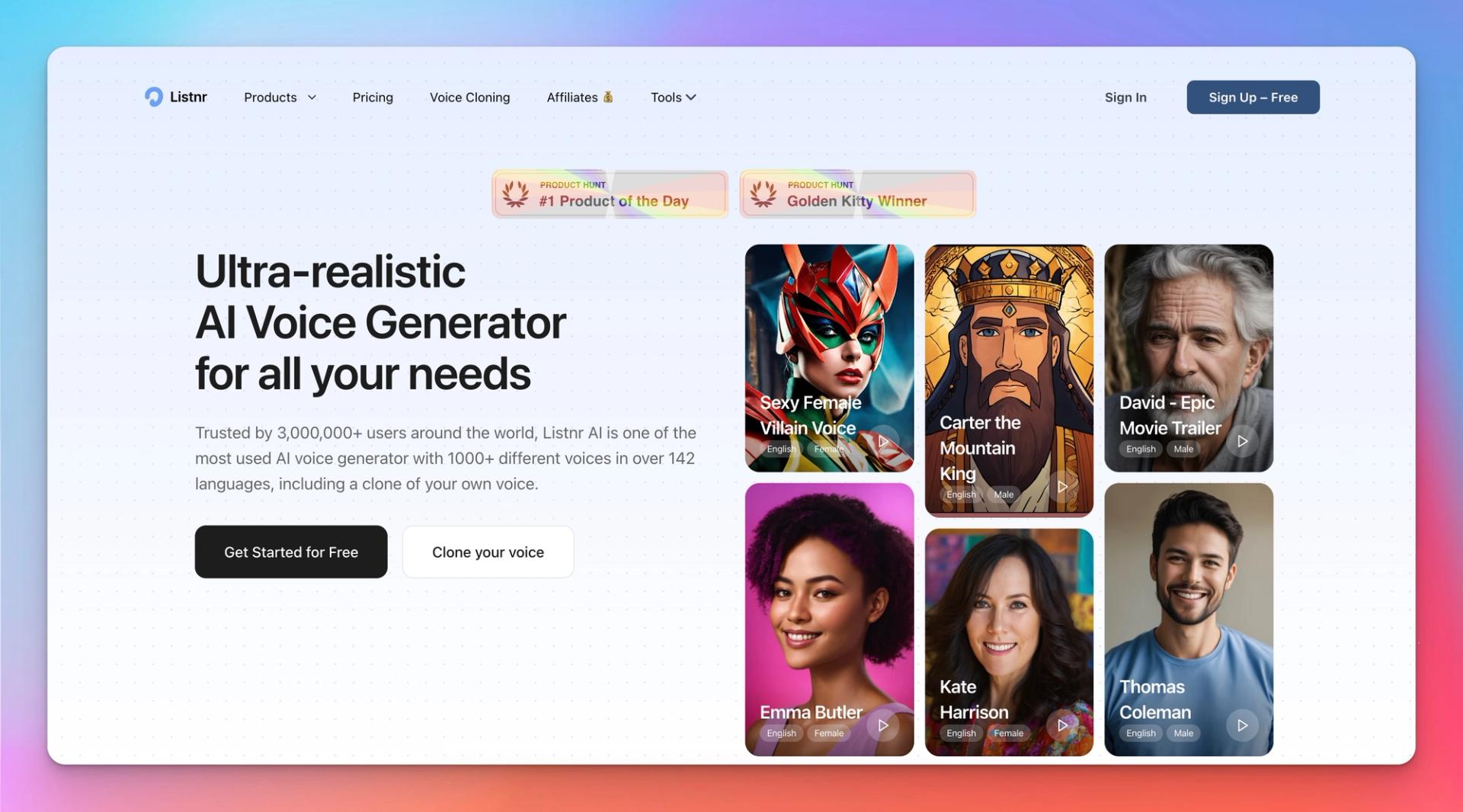
Overview
A production-friendly studio built for shorts, trailers, product demos, podcasts, and course modules. Natural cadence, controllable pacing and pauses, and quick preview loops keep iteration fast.
Key features
- Emotion and pacing controls with per-line adjustments
- Large voice catalog across many languages and dialects
- Batch exports, folders, and shareable projects for teams
Pros
- Fast preview to final render - low babysitting
- Clear quotas and storage per tier - easy to plan
- Strong day-to-day reliability for creators
Cons
- Power users may want more granular SSML hooks in some voices
- Credits can burn quickly on very long content without planning
Latest notes
Expanded voice library and faster render feedback during 2025.
Exact pricing - monthly on annual
Individual $9.50 - Solo $19.50 - Agency $49.50. Annual billing only for these rates.
Best for
Channels shipping frequent content where speed and consistency matter.
2) ElevenLabs - most hyper-real and cinematic
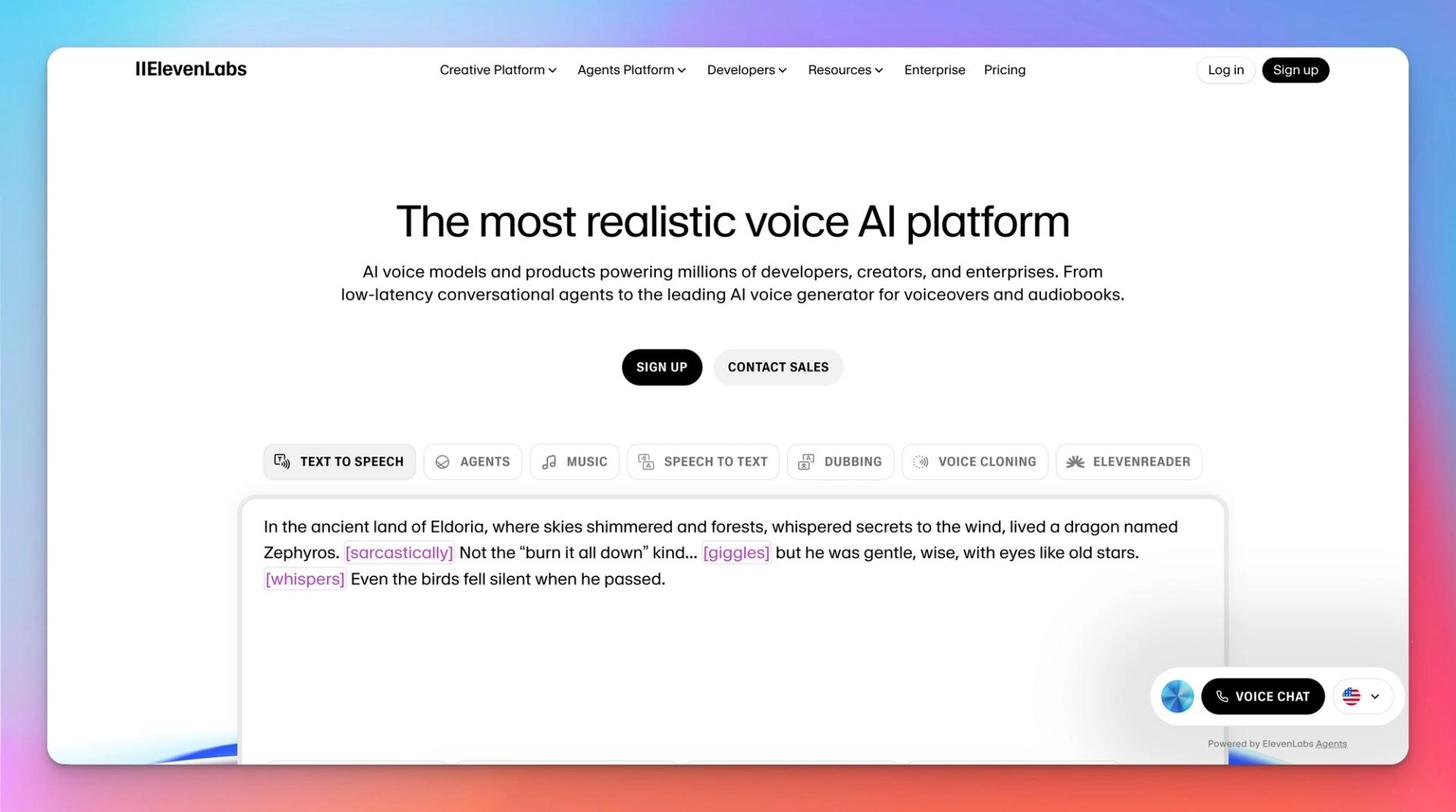
Overview
Cutting-edge realism and style transfer with fast product velocity. Strong choice for trailers, character work, and multilingual dubbing.
Key features
- Expressive voices with style presets and fine emotional range
- Dubbing and multi-language pipelines for long-form content
- Rapidly expanding models and creative tools
Pros
- Top-tier naturalness and emotion - great for hooks and story VO
- Active roadmap and frequent upgrades
Cons
- Credits and usage can spike at scale
- Advanced features require time to master
Latest notes
Heavy investment in 2025 plus adjacent creative features.
Exact pricing - monthly on annual
Starter $5 - Creator $11 - Pro $99 - Scale $330 - Business $1,320.
Best for
Stylized reads, trailers, characters, and premium dubbing.
3) Azure AI Speech - enterprise cloud API at scale
Overview
Microsoft’s neural TTS with regions, SLAs, and commitment pricing. Built for enterprises needing governance and predictable spend.
Key features
- Large voice catalog, custom neural voices, regional hosting
- Batch synthesis and real-time options with enterprise SLAs
- Fine-grained security and compliance controls
Pros
- Attractive unit economics at volume with commitments
- Enterprise support and documentation
Cons
- Seat plans do not apply - budgeting is usage-driven
- Custom voice setup has process overhead
Latest notes
Pricing pages clarified commitment bundles and inclusions.
Exact pricing - usage
Neural TTS $12 per 1M characters at 80M commit - $9.75 per 1M at 400M. Larger bundles available.
Best for
Global apps, IVR fleets, and localization programs on Azure.
4) Amazon Polly - budget workhorse for developers
Overview
Plain-English pricing, solid voices, and bulletproof SDKs. Great for programmatic generation and documentation readers.
Key features
- Standard, Neural, Generative, and Long-Form engines
- SSML support and streaming APIs
- Tight AWS integration and monitoring
Pros
- Extremely predictable cost structure
- Easy automation in existing AWS stacks
Cons
- Realism trails the newest boutique voices in some styles
- Picking engines can confuse beginners
Latest notes
Continued emphasis on free-tier credits for new AWS accounts.
Exact pricing - usage
Standard $4 per 1M chars - Neural $16 per 1M - Generative $30 per 1M - Long-Form $100 per 1M. First-year free-tier applies by engine.
Best for
Cost-conscious apps and high-volume server-side generation.
5) Google Cloud Text-to-Speech - WaveNet and Neural2 on GCP
Overview
Strong quality with WaveNet and Neural2 voices plus a generous recurring free tier. Frictionless for GCP-native teams.
Key features
- Wide voice and locale coverage with frequent refreshes
- gRPC and REST APIs, SSML, and audio profile tuning
- Integrates cleanly with other GCP services
Pros
- Free monthly allowance reduces early costs
- Well-documented and reliable
Cons
- Usage model can be opaque without a simple seat plan
- Some voices vary in emotion control
Exact pricing - usage
Free every month: 4M Standard + 1M WaveNet characters. Then billed per 1M by voice class.
Best for
Product narration, system prompts, and assistants inside GCP.
6) Murf - corporate e-learning and slide-to-VO
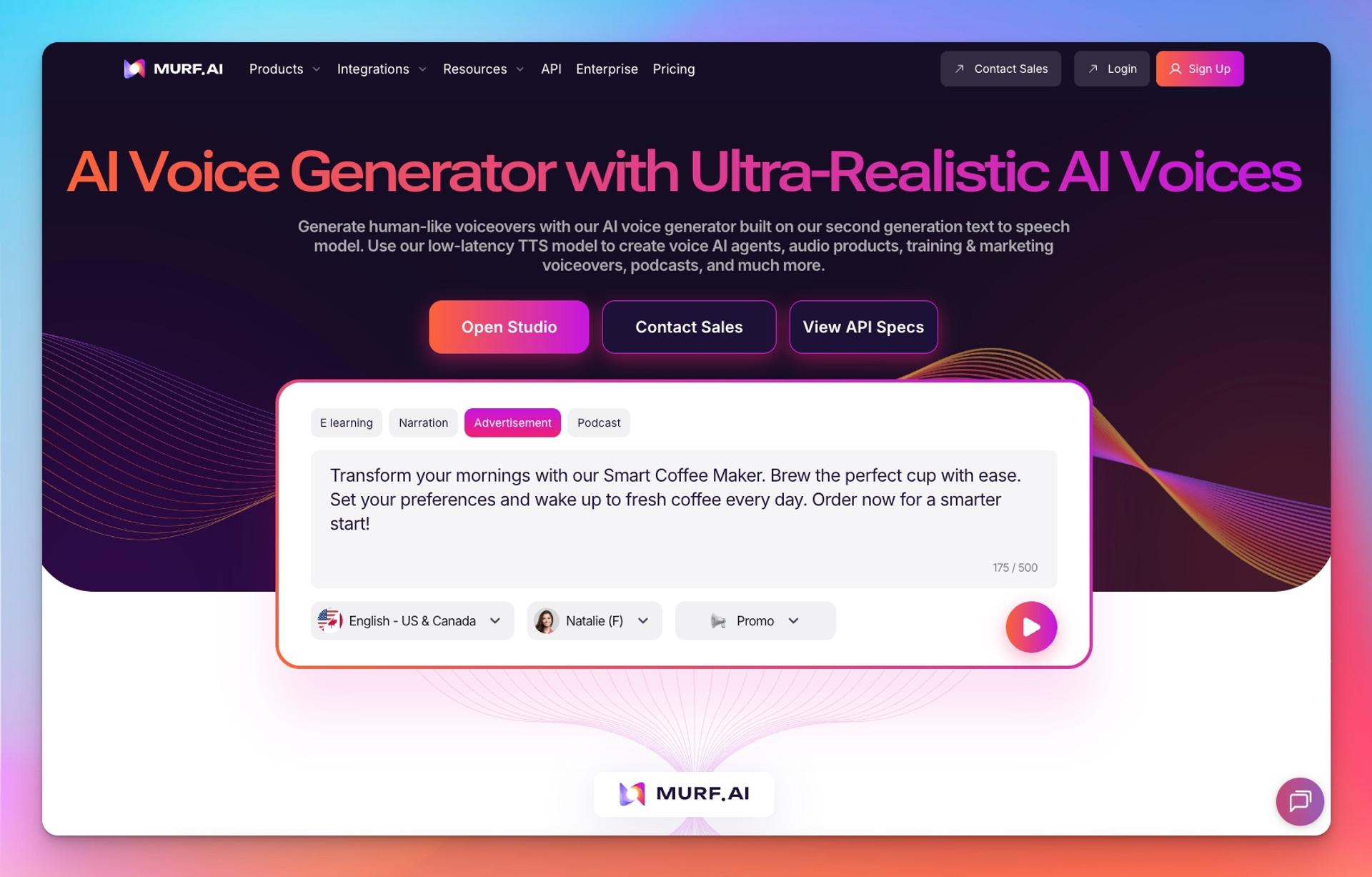
Overview
A studio that turns decks and scripts into consistent training reads. Collaboration and review flows suit HR and L&D.
Key features
- Project sharing, commenting, and brand-consistent output
- Voices tailored for instructional tone
- Batch exports and media timeline tools
Pros
- Low learning curve for non-technical teams
- Predictable output quality for training content
Cons
- Less focus on extreme realism or character styles
- API depth is improving but not cloud-scale like the hyperscalers
Latest notes
New languages added and momentum badges on review platforms.
Exact pricing - monthly on annual
Creator $19 - Business $66. Enterprise custom.
Best for
Corporate training, onboarding, and internal communications.
7) Speechify API - low-latency, pay-as-you-go
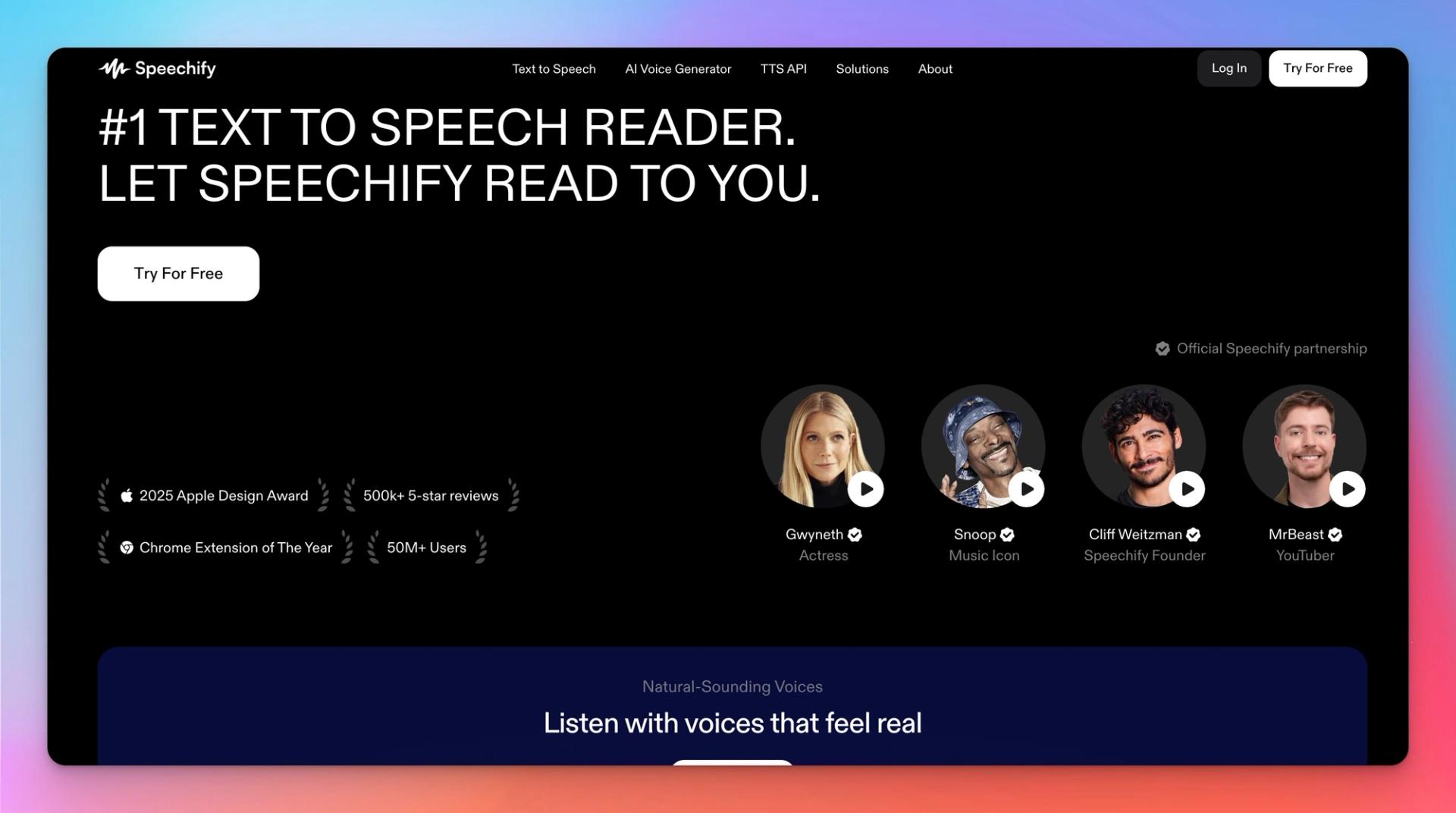
Overview
API focused on speed and scale for reading-first products and voice agents.
Key features
- Sub-second latency targets for live experiences
- Straightforward per-character billing
- Popular consumer brand for listening apps
Pros
- Simple headline price for budgeting
- Good fit for agents, telephony-like flows, and real-time prompts
Cons
- Not a studio replacement - you build workflows yourself
- Cloning and premium features vary by plan
Exact pricing - usage
$10 per 1M characters.
Best for
Low-latency agents and reading experiences where speed matters.
8) Resemble AI - enterprise cloning and deepfake detection
Overview
Voice cloning with consent workflows and multi-modal deepfake detection. A compliance-first approach for regulated teams.
Key features
- Custom voice creation, style controls, and real-time TTS
- Deepfake detection for audio, image, and video
- Project-level management and auditability
Pros
- Serious authenticity tooling and governance
- Suitable for finance, telco, and brand-sensitive work
Cons
- More setup than plug-and-play studios
- Costs can rise with heavy cloning usage
Exact pricing
Creator $19 per month after a $9.50 first month - Professional $99 per month. Annual option not publicly advertised.
Best for
Teams that need provenance, audits, and cloning with guardrails.
9) WellSaid Labs – studio-grade commercial narration
Overview
WellSaid focuses on polished, production-ready narration for training, product explainers, and ads. Voices are consistent, clean, and easy to drop into corporate or brand work without a lot of hand-holding.
Key features
- High-consistency voices tuned for professional narration
- Project/workspace sharing for teams and reviewers
- Text editor with emphasis, pauses, and pronunciation control (lexicons)
- Commercial usage baked into standard tiers
Pros
- “Drop-in ready” tone for corporate, e-learning, and ads
- Simple team workflows with approvals and versioning
- Strong pronunciation tools for product and brand terms
Cons
- Smaller voice/style range than bleeding-edge, character-heavy tools
- API and cloning depth trail specialist developer platforms
Exact pricing – monthly on annual
- Creator $49
- Team $199
(Enterprise available on request.)
What to pick and when
- Daily content with tight turnaround - Listnr.
- Maximum realism and stylized reads - ElevenLabs.
- Millions of characters with governance - Azure AI Speech.
- Pure cost control with solid quality - Amazon Polly.
- GCP stack with WaveNet needs - Google Cloud TTS.
- Training at volume with team workflows - Murf.
- Agent-style, low-latency synthesis - Speechify API or PlayHT.
- Cloning plus authenticity tooling - Resemble AI.
FAQs
How should I compare pricing across tools?
Normalize everything to $/1M characters for APIs or effective $/finished minute for studios. Then layer on latency, export limits, cloning fees, and license terms. Don’t forget promos and annual billing deltas.
Which tool is best for ads and multilingual voiceovers?
Listnr and ElevenLabs are strongest for ad hooks and multilingual VO. Azure, Google, and Polly cover the widest language catalogs for product UI and IVR at scale.
Do these tools support SSML, emotion, and pacing control?
Yes. Listnr supports SSML plus emotion, speed, and pitch controls. Hyperscalers support SSML broadly. Depth of control varies by voice, so audition on your exact script.
What about cloning and legal consent?
Only clone voices you have the rights and consent for. Some vendors require explicit consent flows and may restrict ad or political usage. Keep written consent and follow license terms.
How do I minimize latency for live agents or calls?
Pick a vendor with realtime endpoints, deploy in the closest region, use streaming synthesis, and stick to low bitrate codecs that your telephony stack natively supports.
Are “credits” the same as characters or minutes?
Not always. Some studios bundle exports, storage, and premium voices into a single credit pool. Read plan footnotes and convert to an effective cost per 1M characters or per finished minute.
Which tools are best for long audiobooks or courseware?
For multi-hour narration, cost often favors hyperscalers like Azure or Polly. For polished training reads with reviews and brand consistency, Murf and WellSaid Labs are reliable.
What about licensing for ads, podcasts, and resale?
Check permitted use. Many plans allow commercial use but may limit resale, redistribution, or political ads. Cloned voices often have stricter rules than stock voices.
How do I test language quality, not just coverage?
Run the same 3 to 5 reference paragraphs across vendors, comparing stress, prosody, numerals, acronyms, and brand names. Have a native reviewer sign off.
What data is retained when I render audio?
Policies differ. Some vendors retain text and audio to improve models unless you opt out or use enterprise settings. If privacy is critical, choose tiers with retention controls.

About Ananay Batra
Founder and CEO @ Listnr Inc
Ananay is the Founder & CEO of Listnr AI, he started Listnr with $100 in the bank back in 2020 and scaled it to 3mn+ users across 200 countries and $1.2m in revenue.
https://ananay.ai/